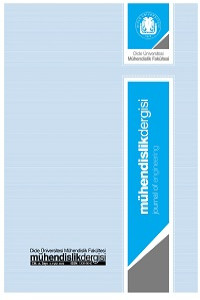Farklı Su/Bağlayıcı Oranına Sahip Betonlarda Nano Silika ve Granüle Yüksek Fırın Cürufu Kullanımın Mekanik ve Elastik Özellikler Üzerine Etkisi
Abstract
Yapılan çalışmada, farklı su/bağlayıcı oranına sahip üç farklı beton karışımına, ağırlıkça %1 oranında nano silika (NS) ve/veya ağırlıkça %20 oranında granüle yüksek fırın cürufu (GYFC) eklenmesi ile birlikte basınç dayanımı, elastisite modülü ve Poisson oranı değerlerinde meydana gelen değişimler ve mineral katkıların, farklı su/bağlayıcı oranlarına sahip beton karışımlarının özellikleri üzerindeki etkinlikleri araştırılmıştır. Elde edilen sonuçlar incelendiğinde, su/bağlayıcı oranı 0,68 olan beton grubunda NS ve/veya GYFC kullanımının beton özelliklerine olumlu bir etkisinin olmadığı görülmüştür. Fakat su/bağlayıcı oranının azalması ile birlikte, mineral katkı kullanımı hem basınç dayanımı hem de elastisite modülü değerleri üzerinde belirgin iyileştirmeler sağlamıştır. Bu etki, özellikle NS ve GYFC’nin birlikte kullanıldığı karışımlarda en yüksek seviyeye ulaşmıştır. Örneğin, 0,53 su/bağlayıcı oranına sahip betonlarda sadece NS veya sadece GYFC kullanımı ile referans karışıma göre basınç dayanımında elde edilen artış oranları sırasıyla %8,8 ve %7,8 iken, NS ve GYFC’nin birlikte kullanılmasıyla artış oranı %15,1 olarak elde edilmiştir. Bunlara ek olarak, Poisson oranı değerlerinin referans betonlarda su/bağlayıcı oranının azalması veya karışımda GYFC kullanılması ile birlikte azaldığı fakat karışıma NS eklenmesi ile birlikte arttığı belirlenmiştir. Bunlara ek olarak, su/bağlayıcı oranının azalmasıyla ve özellikle NS kullanımı ile birlikte, betonun davranışı belirgin bir şekilde lineer-elastik davranışa yakınlaşmıştır.
References
- [1] M. Amin and K. Abu El-Hassan, “Effect of using different types of nano materials on mechanical properties of high strength concrete,” Constr. Build. Mater., vol. 80, pp. 116–124, 2015, doi: 10.1016/j.conbuildmat.2014.12.075.
- [2] J. Björnström, A. Martinelli, A. Matic, L. Börjesson, and I. Panas, “Accelerating effects of colloidal nano-silica for beneficial calcium-silicate-hydrate formation in cement,” Chem. Phys. Lett., vol. 392, no. 1–3, pp. 242–248, 2004, doi: 10.1016/j.cplett.2004.05.071.
- [3] M. Liu, Z. Zhou, X. Zhang, X. Yang, and X. Cheng, “The synergistic effect of nano-silica with blast furnace slag in cement based materials,” Constr. Build. Mater., vol. 126, pp. 624–631, 2016, doi: 10.1016/j.conbuildmat.2016.09.078.
- [4] M. Balapour, A. Joshaghani, and F. Althoey, “Nano-SiO2 contribution to mechanical, durability, fresh and microstructural characteristics of concrete: A review,” Constr. Build. Mater., vol. 181, pp. 27–41, Aug. 2018, doi: 10.1016/j.conbuildmat.2018.05.266.
- [5] M. Jalal, E. Mansouri, M. Sharifipour, and A. R. Pouladkhan, “Mechanical, rheological, durability and microstructural properties of high performance self-compacting concrete containing SiO2 micro and nanoparticles,” Mater. Des., vol. 34, pp. 389–400, 2012, doi: 10.1016/j.matdes.2011.08.037.
- [6] R. Prashanth, S. Senthil Selvan, and M. Balasubramanian, “Experimental investigation on durability properties of concrete added with nano silica,” Rasayan J. Chem., vol. 12, no. 2, pp. 685–690, 2019, doi: 10.31788/RJC.2019.1225165.
- [7] N. Atmaca, M. L. Abbas, and A. Atmaca, “Effects of nano-silica on the gas permeability, durability and mechanical properties of high-strength lightweight concrete,” Constr. Build. Mater., vol. 147, pp. 17–26, 2017, doi: 10.1016/j.conbuildmat.2017.04.156.
- [8] M. Berra, F. Carassiti, T. Mangialardi, A. E. Paolini, and M. Sebastiani, “Effects of nanosilica addition on workability and compressive strength of Portland cement pastes,” Constr. Build. Mater., vol. 35, pp. 666–675, 2012, doi: 10.1016/j.conbuildmat.2012.04.132.
- [9] M. Y. Durgun and H. N. Atahan, “Rheological and fresh properties of reduced fine content self-compacting concretes produced with different particle sizes of nano SiO2,” Constr. Build. Mater., vol. 142, pp. 431–443, 2017, doi: 10.1016/j.conbuildmat.2017.03.098.
- [10] P. K. Hou, S. Kawashima, K. J. Wang, D. J. Corr, J. S. Qian, and S. P. Shah, “Effects of colloidal nanosilica on rheological and mechanical properties of fly ash-cement mortar,” Cem. Concr. Compos., vol. 35, no. 1, pp. 12–22, 2013, doi: 10.1016/j.cemconcomp.2012.08.027.
- [11] A. Nazari and S. Riahi, “The effects of SiO2 nanoparticles on physical and mechanical properties of high strength compacting concrete,” Compos. Part B Eng., vol. 42, no. 3, pp. 570–578, 2011, doi: 10.1016/j.compositesb.2010.09.025.
- [12] L. G. Li, J. Y. Zheng, J. Zhu, and A. K. H. Kwan, “Combined usage of micro-silica and nano-silica in concrete: SP demand, cementing efficiencies and synergistic effect,” Constr. Build. Mater., vol. 168, pp. 622–632, 2018, doi: 10.1016/j.conbuildmat.2018.02.181.
- [13] M. Gesoglu, E. Güneyisi, D. S. Asaad, and G. F. Muhyaddin, “Properties of low binder ultra-high performance cementitious composites: Comparison of nanosilica and microsilica,” Constr. Build. Mater., vol. 102, pp. 706–713, 2016, doi: 10.1016/j.conbuildmat.2015.11.020.
- [14] A. M. Sharkawi, M. A. Abd-Elaty, and O. H. Khalifa, “Synergistic influence of micro-nano silica mixture on durability performance of cementious materials,” Constr. Build. Mater., vol. 164, pp. 579–588, 2018, doi: 10.1016/j.conbuildmat.2018.01.013.
- [15] M. Jalal, A. Pouladkhan, O. F. Harandi, and D. Jafari, “Comparative study on effects of Class F fly ash, nano silica and silica fume on properties of high performance self compacting concrete,” Constr. Build. Mater., vol. 94, pp. 90–104, 2015, doi: 10.1016/j.conbuildmat.2015.07.001.
- [16] Turkish Standards Institution, “Design of Concrete Mixes (TS 802),” 2016.
- [17] Turkish Standards Institution, “Testing fresh concrete, Part 2: Slump test (TS EN 12350-2:2019),” 2019.
- [18] Turkish Standards Institution, “Testing fresh concrete, Part 6: Density (TS EN 12350-6:2019),” 2019.
- [19] Turkish Standards Institution, “Testing hardened concrete, Part 3: Compressive strength of test specimens (TS EN 12390-3:2019),” 2019.
- [20] Z. Xu, Z. Zhou, P. Du, and X. Cheng, “Effects of nano-silica on hydration properties of tricalcium silicate,” Constr. Build. Mater., vol. 125, pp. 1169–1177, 2016, doi: 10.1016/j.conbuildmat.2016.09.003.
- [21] H. N. Turkmenoglu and H. N. Atahan, “Deformation Properties of Nano-Silica Modified Concrete Mixtures under Uniaxial Compression Loading,” Arab. J. Sci. Eng., vol. 46, no. 11, pp. 11009–11025, 2021, doi: 10.1007/s13369-021-05431-y.
Details
| Primary Language | Turkish |
|---|---|
| Journal Section | Articles |
| Authors | |
| Early Pub Date | September 30, 2022 |
| Publication Date | September 30, 2022 |
| Submission Date | July 23, 2022 |
| Published in Issue | Year 2022 Volume: 13 Issue: 3 |

